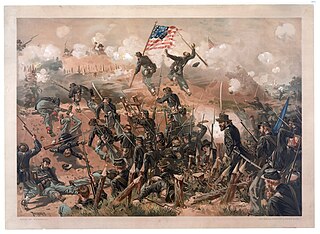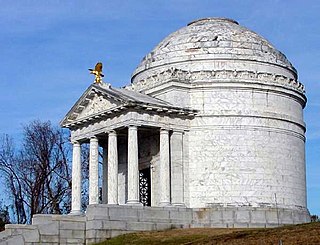
Port Gibson is a city in Claiborne County, Mississippi, United States. The population was 1,567 at the 2010 census. Port Gibson is the county seat of Claiborne County, which is bordered on the west by the Mississippi River. It is the site of the Claiborne County Courthouse.

The Siege of Vicksburg was the final major military action in the Vicksburg campaign of the American Civil War. In a series of maneuvers, Union Major General Ulysses S. Grant and his Army of the Tennessee crossed the Mississippi River and drove the Confederate Army of Mississippi, led by Lieutenant General John C. Pemberton, into the defensive lines surrounding the fortress city of Vicksburg, Mississippi, leading to the successful siege and Confederate surrender.

Windsor Ruins are in Claiborne County, Mississippi, United States, about 10 miles (16 km) southwest of Port Gibson near Alcorn State University. The ruins consist of 23 standing Corinthian columns of the largest antebellum Greek Revival mansion ever built in the state. The mansion stood from 1861 to 1890, when it was destroyed by fire. The 2.1-acre (0.85 ha) site with the columns was added to the National Register of Historic Places in 1971 and was designated a Mississippi Landmark in 1985.

The Vicksburg campaign was a series of maneuvers and battles in the Western Theater of the American Civil War directed against Vicksburg, Mississippi, a fortress city that dominated the last Confederate-controlled section of the Mississippi River. The Union Army of the Tennessee under Major General Ulysses S. Grant gained control of the river by capturing this stronghold and defeating Lieutenant General John C. Pemberton's forces stationed there.

Richard "Dick" Taylor was an American planter, politician, military historian, and Confederate general. Following the outbreak of the American Civil War, Taylor joined the Confederate States Army, serving first as a brigade commander in Virginia and later as an army commander in the Trans-Mississippi Theater. Taylor commanded the District of West Louisiana and opposed United States troops advancing through upper northwest Louisiana during the Red River Campaign of 1864. He was the only son of Zachary Taylor, the 12th president of the United States. After the war and Reconstruction, Taylor published a memoir about his experiences.

The Battle of Big Black River Bridge was fought on May 17, 1863, as part of the Vicksburg Campaign of the American Civil War. During the war, the city of Vicksburg, Mississippi, was a key point on the Mississippi River. On April 30, 1863, a Union army commanded by Major General Ulysses S. Grant began crossing onto the east side of the Mississippi River as part of a campaign against Vicksburg. After engaging and defeating Confederate forces in several intermediate battles, Grant's army defeated Lieutenant General John C. Pemberton's Confederates at the decisive Battle of Champion Hill on May 16. During the retreat from Champion Hill, one division of Pemberton's army, commanded by Major General William W. Loring, was cut off from Pemberton's main body. Pemberton did not know the location of Loring's division, and he held a bridgehead on the east side of the Big Black River to cover Loring's anticipated withdrawal across the river on the morning of May 17.

Vicksburg National Military Park preserves the site of the American Civil War Battle of Vicksburg, waged from March 29 to July 4, 1863. The park, located in Vicksburg, Mississippi, also commemorates the greater Vicksburg Campaign which led up to the battle. Reconstructed forts and trenches evoke memories of the 47-day siege that ended in the surrender of the city. Victory here and at Port Hudson, farther south in Louisiana, gave the Union control of the Mississippi River.

The Battle of Port Gibson was fought between a Union Army commanded by Major General Ulysses S. Grant and a reinforced Confederate States Army division led by Major General John S. Bowen. Though the outnumbered Confederate soldiers fought stubbornly, they were steadily pressed back during the day by Major General John A. McClernand's troops. Bowen eventually conceded the field by withdrawing north toward Vicksburg, Mississippi. The battle occurred near Port Gibson, Mississippi, during the Vicksburg Campaign of the American Civil War.

The Battle of Grand Gulf was fought on April 29, 1863, during the American Civil War. Union Army forces commanded by Major General Ulysses S. Grant had failed several times to bypass or capture the Confederate-held city of Vicksburg, Mississippi, during the Vicksburg campaign. Grant decided to move his army south of Vicksburg, cross the Mississippi River, and then advance on the city. A Confederate Army division under Brigadier General John S. Bowen prepared defenses—Forts Wade and Cobun—at Grand Gulf, Mississippi, south of Vicksburg. To clear the way for a Union crossing, seven Union Navy ironclad warships from the Mississippi Squadron commanded by Admiral David Dixon Porter bombarded the Confederate defenses at Grand Gulf on April 29. Union fire silenced Fort Wade and killed its commander, but the overall Confederate position held. Grant decided to cross the river elsewhere.

The Battle of Snyder's Bluff was fought from April 29 to May 1, 1863, during the Vicksburg Campaign of the American Civil War. Federal Major General Ulysses S. Grant had decided to move most of his army down the west bank of the Mississippi River and then cross south of Vicksburg, Mississippi, at Grand Gulf as part of his campaign against the city. To cover his planned crossing, Major General William T. Sherman took Francis P. Blair Jr.'s division of his XV Corps on a maneuver up the Yazoo River to feint at Confederate defenses at Snyder's Bluff and Drumgould's Bluff.
Disharoon's plantation was located in Tensas Parish, Louisiana and was used as a steamboat landing on the Mississippi River by Union Army General Ulysses S. Grant during the American Civil War.

Grand Gulf is a ghost town in Claiborne County, Mississippi, United States.
The Port Gibson Battlefield is the site near Port Gibson, Mississippi where the 1863 Battle of Port Gibson was fought during the American Civil War. The battlefield covers about 3,400 acres (1,400 ha) of land west of the city, astride Rodney Road, where Union Army forces were establishing a beachhead after crossing the Mississippi River in a bid to take the Confederate fortress of Vicksburg. The Union victory secured that beachhead and paved the way for the eventual fall of Vicksburg. A 2,080-acre (840 ha) area surrounding part of the site was listed on the National Register of Historic Places in 1972, and a larger area was designated a National Historic Landmark in 2005. In 2009, the battlefield was designated by the Civil War Preservation Trust as one of its Top 10 most endangered Civil War battlefields. In 2011, the Civil War Preservation Trust was renamed the Civil War Trust, which in 2018 became a division of the American Battlefield Trust. The Trust and its partners have acquired and preserved 644 acres (2.61 km2) of the Port Gibson battlefield.
The Battle of Richmond was fought on June 15, 1863, near Richmond, Louisiana, during the Vicksburg campaign of the American Civil War. Major General John George Walker's division of Confederate troops, known as Walker's Greyhounds had attacked Union forces in the Battle of Milliken's Bend and the Battle of Lake Providence earlier that month in hopes of relieving some of the pressure on the Confederate troops besieged in Vicksburg, Mississippi. While both of Walker's strikes were failures and the Confederates withdrew to Richmond, Union Major General Ulysses S. Grant still viewed the presence of Walker's men at Richmond to be a threat. On June 14, the Mississippi Marine Brigade and the infantry brigade of Brigadier General Joseph A. Mower were sent to attack the Confederates at Richmond.

The Battle of Lake Providence was fought on June 9, 1863, during the Vicksburg campaign of the American Civil War. Confederate troops from the Trans-Mississippi Department were trying to relieve Union pressure during the Siege of Vicksburg. Major General Richard Taylor, primarily utilizing Walker's Greyhounds, prepared a three-pronged attack against Union positions at Milliken's Bend, Young's Point, and Lake Providence. The strike against Lake Providence was conducted by 900 men led by Colonel Frank Bartlett.
The 16th Regiment Indiana Infantry was an infantry regiment in the Union Army during the American Civil War. In August 1863, the regiment was converted to mounted infantry for the remainder of the war.

Bayou Pierre is a river in Louisiana and Mississippi, United States. It is a tributary of the Mississippi River merging just downstream from the town of St. Joseph, Louisiana on the opposite bank.

The 3rd United States Colored Cavalry was a regiment in the United States Army organized as one of the units of the United States Colored Troops during the American Civil War. The regiment was originally formed in October 1863 at Vicksburg, Mississippi as the 1st Mississippi Cavalry Regiment. The unit soon began taking part in expeditions near Vicksburg. In February–March 1864, the regiment saw action at Yazoo City. After being renamed the 3rd U.S. Colored Cavalry in March 1864, the regiment continued to participate in raids, including the Yazoo City expedition in May. In December 1864, the unit took part in a successful raid led by Benjamin Grierson during which the Battle of Egypt Station and other actions were fought. The regiment operated near Memphis, Tennessee, until April 1865, after which it returned to Vicksburg for occupation duties. The soldiers were mustered out of federal service in January 1866.
The Duckport Canal was an unsuccessful military venture by Union forces during the Vicksburg campaign of the American Civil War. Ordered built in late March 1863 by Major General Ulysses S. Grant, the canal stretched from the Mississippi River near Duckport, Louisiana, to New Carthage, Louisiana, and utilized a series of swampy bayous for much of its path. It was intended to provide a water-based supply route for a southward movement against the Confederate-held city of Vicksburg, Mississippi, as high water levels made overland travel difficult. Manual digging was provided by 3,500 soldiers from Grant's army and was finished on April 12. The next day, the levee separating the canal cut and the Mississippi River was breached, and water flowed into the canal. Trees that had grown up in the bayous and falling water levels that reached as shallow as 6 inches (15 cm) at one point hampered the use of the canal, and the project was abandoned on May 4. Grant moved men and supplies through the overland route, which had been made more accessible by the same falling water levels that doomed the canal. After some inland maneuvering and a lengthy siege, Vicksburg surrendered on July 4, marking a significant turning point in the war.

Steele's Greenville expedition took place from April 2 to 25, 1863, during the Vicksburg campaign of the American Civil War. Union forces commanded by Major General Frederick Steele occupied Greenville, Mississippi, and operated in the surrounding area, to divert Confederate attention from a more important movement made in Louisiana by Major General John A. McClernand's corps. Minor skirmishing between the two sides occurred, particularly in the early stages of the expedition. Over 1,000 slaves were freed during the operation, and large quantities of supplies and animals were destroyed or removed from the area. Along with other operations, including Grierson's Raid, Steele's Greenville expedition distracted Confederate attention from McClernand's movement. Some historians have suggested that the Greenville expedition represented Union war policy shifting more towards expanding the war to Confederate social and economic structures and the Confederate homefront.


















